Taste. Season.
As I was attempting to proof-read my new e-cookbook recently, I realised that they are probably the two most repeated words, well maybe after tablespoon and cup. But arguably the most important instructions in any recipe method.
Which got me thinking about when I was getting into cooking. I remember always being nervous when I came to the bit in a recipe when it said ‘season to taste’. I knew that meant adding salt and pepper. But how could I possibly know how much? For years I’d just add a few grinds of pepper and a pinch of salt and hope for the best. That was until I had a bit of a seasoning revelation.
I was travelling in Mexico and signed up for a 1 day market tour and cooking class just outside the beautiful city of Oaxaca. I was expecting the most enlightening part of the day to be the bit when we ate chilli and lime fried grasshopper. But I was wrong.
As we broke up into groups to cook our assigned dishes, I was a little underwhelmed by the thought of making a fish soup. But as my team got going, we had a heap of fun. When the instructor came round to check on our progress, we were proud to announce that the soup was done.
After tasting, she inquired as to whether we’d seasoned it and got us to taste as well. I thought it was pretty good, but at her insistence we added a more salt. A second taste and the difference was staggering. With our instructor’s encouragement we continued to salt and taste. Each time the soup tasted more alive and vibrant, not salty but fresh and good.
It was then that I realised that this is what seasoning is about – tasting and tweaking – or fine tuning to bring out the best in the food. After that, I felt more confident with the whole seasoning thing and began to experiment with my own cooking. I like to think of seasoning as an art that I’m continuing to practice and improve.
what is seasoning?
Seasoning is about improving the flavour of your food mostly via the addition of salt and pepper. Although herbs, spices, sweet things and acidic things can also be considered seasoning, we’ll focus on salt and pepper for today.
how do I go about seasoning a dish?
There are two main times to think about seasoning – the beginning and the end. For slow cooked dishes it’s a good idea to get some salt in early so it can spread through the whole dish over time. For most other things seasoning at the end is the best way to go.
Before you serve, have a little taste of your dish and ask yourself these questions:
i. Does this taste delicious as is? Or are the flavours a little dull?
ii. Would it taste (even) better with some salt and pepper?
If you’re a little unsure, you can take out a little sample and add some salt and pepper to it. Taste and compare to the original. If it tastes better, add salt to the dish. If not then you’re ready to serve. It’s all about backing yourself and trusting your judgement.
what should I use?
If you don’t own a pepper grinder, at least get yourself one of those supermarket disposable bottles of peppercorns. There is no substitute for the fragrance of freshly ground pepper. I like to use the best black peppercorns I can afford, as I find that white pepper has a faint air of B.O. about it. But it’s up to you.
For salt, I keep two kinds.
i. Inexpensive fine sea salt for bulk seasoning things like pasta water or for making brine.
ii. Sea Salt flakes, usually Maldon that have a lovely large flake structure that make them perfect for crushing over things at the last minute.
Iodised salt is great for people that don’t get any seafood in their diet and might be iodine deficient, but I prefer to eat fish and have my salt clean tasting.
what happens if I overdo it?
We’ve all been a bit heavy handed with the salt at times. Although I can’t remember ever having a pepper overdose.
To be honest about the only way you can fix serious over-salting is to dilute the dish. Which can be tricky unless it’s a soup or stewy type thing. Serving with unsalted accompaniments, like mashed potato made with unsalted butter, or skipping the salt in the pasta water can help.
The best bet is to serve lots of water and hope nobody notices. The power of suggestion can really sway peoples’ taste perceptions so best not to alert your diners to the over-salting situation.
other seasoning tips
think about the saltiness of your ingredients
One of the best ways to anticipate whether you’re going to need any extra seasoning is to have a think about how much salt each ingredient is contributing. If there are a heap of olives, anchovies, capers or bacon, for example, the dish will probably already be sufficiently salty.
beware of taste saturation
Remember that when your taste buds have been exposed to something a few times, they become less sensitive to those flavours. So if you’ve been tasting and tweaking for a while, it’s good to have a break and a glass of water, and ideally take 5 minutes out of the kitchen. The other option is to get a second opinion from someone else.
consider your accompaniments & the end use
If you’re making a filling for pies, remember that it’s going to be eaten with the pastry so a little bit more salt might not be a bad thing.
allow for the serving temperature
The colder things are, the duller the flavours (or really the less we perceive them). Best to taste and season at the serving temperature if you can, otherwise try and allow for differences in temperature.
consider individual preferences and sensitivities
Everyone is different. People who rarely eat salty food will be more sensitive than those who eat out all the time. Likewise, younger people tend to be more taste sensitive than the elderly. The answer is to season as much as you think it needs, but serve some salt at the table for your guests to fine tune, if desired.
always err on the ‘less is more’
As we’ve already covered, removing excess salt is pretty much impossible, so best to season gradually.
it’s OK to expectorate
One of the most useful skills I learnt during my time as a winemaker was how to spit like a champion. Now I know the thought can be a little gross for some people, I’d much rather spit as I’m tasting and seasoning and still feel like eating when I sit down to dinner, rather than that feeling of being absolutely stuffed before the meal has even begun. It’s up to you really.
[5 ingredients | 10 minutes]
butter beans with tomato & chorizo
serves 2
This dish is an absolute favourite of mine that I blogged about back in 2008. I’ve actually streamlined it over the years so that it’s now in the 5 ingredients | 10 minutes league. You’ll be happy to know that this version tastes just as good, if not better than the original – a fact verified by a certain Irishman when I made it for the photo the other day.
One of the things that has really cut down on preparation time, is the discovery of Barilla’s arrabbiata pasta sauce. I’m not usually a fan of preprepared sauces, but this one has a lovely tomato-ness without any of the fake herb flavours or sweetness you normally see. If you have a preferred pasta sauce brand, please go ahead and use it. Or if you prefer to do things from almost-scratch, substitute in a tin of tomatoes and allow an extra 10 minutes or so for them to simmer.
I love these beans for brunch. Sometimes if I know there’s a big night on the agenda, I’ll cook up the beans and have them ready to warm up in the morning and finish off with a fried egg, some toast, and a little restorative green salad – the hangover breakfast of champions (!) It’s also delicious on its own as a simple beans on toast supper.
For a vegetarian version, skip the chorizo and substitute in some smoked tofu and a tablespoon of smoky paprika.
1 chorizo (approx 150g / 5oz), sliced into coins
1 can butter beans (400g/14oz), drained
1 cup Barilla Arrabbiata sauce, or other pasta tomato sauce
1 tablespoon red wine vinegar
1 bunch chives, finely chopped
Heat a few tablespoons olive oil in a frying pan over a medium high heat. Add chorizo and cook, stirring occasionally for a few minutes or until browned on both sides.
Add beans, sauce and vinegar. Simmer for a few minutes until everything is hot. Taste and season (!) Stir through chives and leave some to sprinkle on top.
__________________________________________________________
Have updated the stonesoup recipe index this week. Feel free to have a browse.
A big THANKYOU to everyone who helped spread the word about my new FREE e-cookbook. It’s still available to download, or if you are interested in a proper paper copy, head on over to my blurb store… but be warned paper is expensive. The price does not contain any markup – it’s purely blurb’s cost to produce.
Share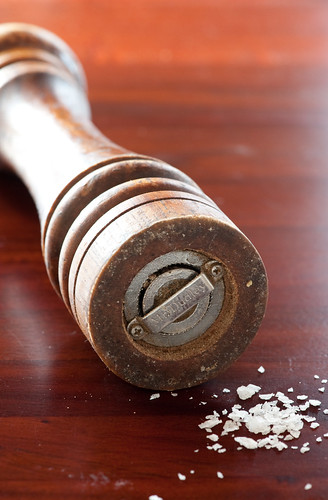
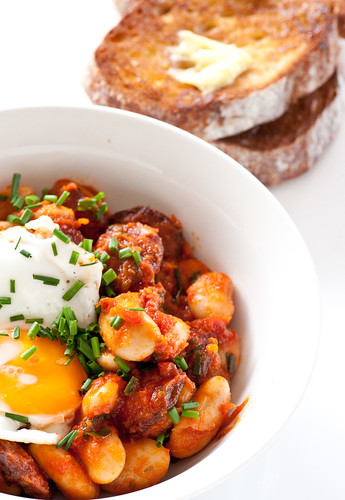
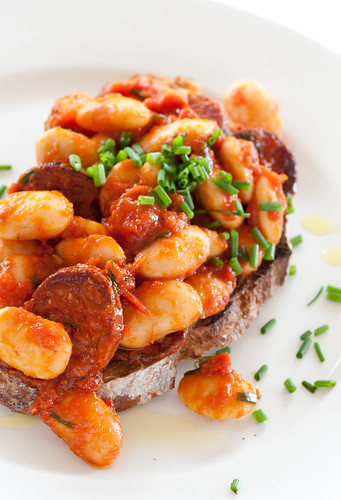
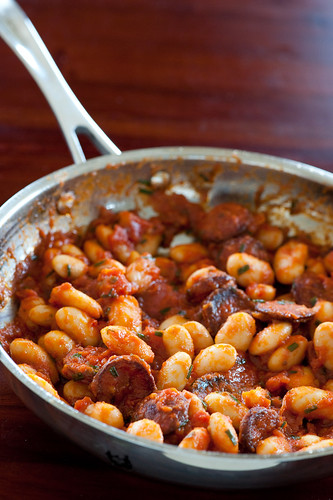



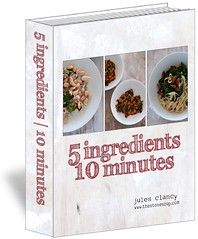
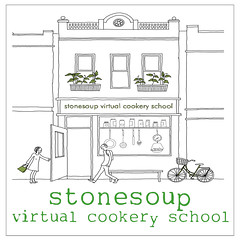
{ 7 trackbacks }
{ 30 comments… read them below or add one }
This post was so needed – I’ve never really done a proper taste and season. I’m pretty sensitive to the taste of salt, personally, I very rarely use it at all and have never added it to my food at the table, I love freshly ground pepper probably too much! I’ll try experimenting with adding the salt a little at a time, to see if I can appreciate the difference.
So many of the ingedients we buy have so much salt in then already, I only buy one brand of stock cubes because I find many of the others make my soup taste like brine. I need to start making my own stock more often!
Thanks for the email with a link to your ebook, it was wonderful, I’m looking forward to trying out a lot of the recipes in there. I also just spent a few days in Barcelona but was so busy with work I didn’t manage to visit many of the places from you other book which I really wanted to. I need to head back there soon! (not too far from Scotland)
This recipe is very similar to one of our favourites, butter bean and chorizo stew but with tinned tomatoes instead of sauce and a few other minor changes. I really like the way you’ve served it on toast like a sort of bruscetta. It looks more attractive than the way we usually pile it in a bowl with a hunk of bread on the side!
Thanks so much for these tips! I’m trying to cultivate my tastebuds and knowing how to season food is a great step in the right direction. These are really helpful! :) Great post.
Wei-Wei
I’m so excited; I have all the ingredients for this recipe and I can’t wait to try it today. Thanks for sharing.
Great post! I often write the same (season to taste) in my recipes and wonder if my readers will know what I’m talking about. In fact, I think I’ll share this with my readers!
1) Great post on how to “season to taste”, especially the explanation about salt not necessarily used to make things salty, but to elevate dull flavors.
2) Amen about white pepper! I can always tell when there’s even a hint of white pepper in something…I get that whiff of slight b.o.
3) This recipe sounds great – Yum!
I have really enjoyed looking through your e-cookbook. The recipes sound fantastic! For many of the desserts you use cream, and I am confused about the different types. What is the difference between pouring and double cream? Thanks so much; I’m looking forward to some new summer dishes!
Great post and too true.
As a chef, the greatest challenge in teaching people how to cook is not ingredients, recipes or technique – but understanding about tasting and tweaking seasoning and actually do it each and every time.
Here in Thailand condiment sets are on every table everywhere, and balancing hot, sweet, sour and salty is second nature to every diner.
In the West we seem to just eat what’s offered. You exposed the secret to great taste.
Very helpful post – my husband almost always has a dig at me for not tasting my food enough – but I had the “felt too full didn’t want to then it it” problem – maybe spitting is the answer. The kids will be thrilled!
Butter beans are awesome. As is chorizo. I want to make this right now! and I’m glad you have an additional taster present – if only for our benefit of course ;-). Stay happy.
“then eat it” I meant.. but sure you caught my drift.. anyway..
Excellent guide to beginning seasoning. Thank you.
Good tip well written J..Being old school I’ve always experimented adding one spice at a time then tasting it to see how it complimented the flavor if not don’t add it as so many dishes are over seasoned today. Think some people think the more seasoning you add the better it should be? I can remember my mom always complaining to me about my brothers cooking being way too hot & spicy as she liked her food more towards mild & salty. MY sister complained about her salt & fats. Thus I found most seasoning preference depends basically where you were raised as everyone has their own personal taste especially when it comes to seasoning food. We were brainwashed based on how momma cooked. What bothers me is when I see someone immediately start adding salt, sugar or pepper on everything before even tasting the food? They add sugar if they over salted and you wonder why we have so many issues today?
Stinky white pepper! So true, I thought I was the only one! :-)
I grew up not using salt in anything, then when I went to culinary school, I learned how to season to taste. It was amazing! Of course, now when I eat my parents’ food, it’s horribly undersalted, but I just add it to my own plate and it’s fine.
A couple foods that can take (and benefit greatly from) a lot of salt: spinach and potatoes. In school, we made this Indian spinach dish (can’t remember what it was called) but it tasted like nothing, despite the fact that we made our own garam masala, toasting the spices and everything. Then we remembered to add salt, and suddenly all the flavors came out to play! Just like magic!
You don’t mention the egg in the recipe but that top photo with that egg rocks my world (in a very good way). GREG
Just discovered your blog and I am inlove.
seasoning is still a mystery to me but I am learning to be more bold with seasoning when needed – I have also found that a good home made stock adds such depth of flavour – and that lemon juice helps when I oversalt – I think I heard that a potato helps in a stew that is too salty
For the pepper, if I can give you a gourmet advise for add.. Use Kampot Pepper, this pepper is very tasty and fragrant.. nothing to compare with pepper from supermarket. It is a very simple ingredient but it can change a lot.
Interesting post, but what about all the other seasonings available? I struggle with seasonings because I cook meat dishes for my husband, but I don’t eat meat (never have!) I make my best guesses at seasonings and he is very nice and doesn’t complain :)
great post…. when ever I am serving a group I tend to always stay on the under seasoned side because as you mentioned you can always add more but taking some away is more difficult. I find I am more adventurous when I am just cooking for my boyfriend and myself because I know he prefers it seasoned to an excess! I do like using fresh herbs as well as other flavors in addition to salt & pepper though as I think they add more dimensions to the dish
beautiful photos, as always. thanks for the info.
A trick my mother taught me when you over salted food was to toss a potato in it. The potato soaks up salt. As long as the potato will not kill the dish then pull it out afterwards.
My daughter and I are sharing this for lunch, her face is bright red, her hands are unspeakable and she is beaming! So am I, though I’m showing slightly less on my person (but only slightly you understand). Yum.
I found this post incredibly interesting. Growing up with health concious parents, we were taught from an early age that salt is never to be added to dishes, as it wasn’t ‘good’ for us to have salty food. As a result, we never had salt in the house, and sort of looked at people like they were piggy junk food addicts if they heaped on salt at restaurants etc. About a year ago though I started adding salt to season meals, and I couldn’t believe how much it could elevate the taste, and make the meal taste so much better. You’re right… seasoning with salt doesn’t make it salty, it makes it delicious! I’m a total convert now!
Great post:) I like the idea of removing a little portion of a dish and seasoning this as a guide to the amount required for the whole dish. Rather than over seasoning the entire thing and ruining it…which I’ve done!
Speaking of, adding a peeled potato to an over-salted soup, pasta sauce, tagine, braise, etc, and cooking for 15-20mins will absorb much of the additional salt :) just taste as per usual until it resumes a desired level!
thanks for the comments everyone. glad i’m not the only one with a thing against white pepper!
allison,
good question about pouring cream v’s double cream. I’m planning to write a more detailed post about cream terminology from around the world but in short pouring cream has about 35% milk fat and double cream is in the 45-48% range.
tom
thanks for sharing your family story. completely agree that it’s very annoying when people start adding salt at the table without even tasting the food first
mirra, brandon, johanna,
thanks for the suggestion of the potato for correcting oversalting. Interestingly I’ve just read a food science book called ‘what einstein told his cook’ that mentions oversalting. The author actually did an experiment with potato to see whether the potato could absorb the excess salt. he measured the salt content of the potato before and after and found no change. I haven’t tried it myself but not sure if the potato will work – although if it tastes better to you then that’s all that matters
claire
so cute to think of your daughter getting into the chorizo & bean – thanks for sharing
chef shane
you’re absolutely right – thai cooking is the ultimate in seasoning with the balance of sweet, salty, sour and hot – and I love the culture of adjusting to taste at the table – something to aspire to!
My mother-in-law’s cure for over salted stews: a chunk of raw potato, just as many others commented. Of course, she suggested raw potato for infected sores with the same breath so I didn’t get very excited. But seriously, it works. I’ve never looked at my mil the same since.
I made this for dinner, over toast made from German bread, with a beautifully cooked egg on top (firm white, runny yolk) as inspired by the picture. Oh…My…Word. So good! And to think that I almost settled for crappy takeaway because I couldn’t be bothered cooking!
What a useful post!!! Seasoning is one of the biggest mysteries of cooking to the new chef, and your guide breaks it down beautifully!
I love fresh ground pepper, but recently I have been using Grains of Paradise as a replacement. It’s a much more complex peppery flavor. Seared steaks with a Grains of Paradise crust is a must try!
I was seeking on google and I stumbled in your web-site. Very good page you have got here. I’ve shared it to my pal who was looking for such info. I am pretty certain this may allow him an awful lot.